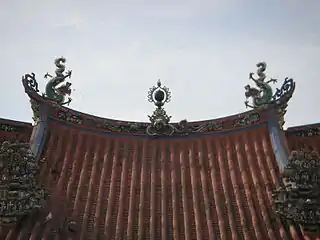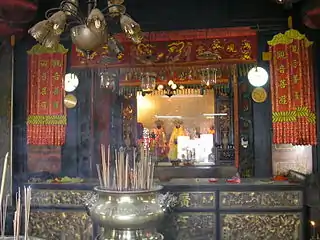Goddess of Mercy Temple
The Goddess of Mercy Temple (Chinese: 觀音亭; Pe̍h-ōe-jī: Koan-im-têng) (also known as Kuan Im Teng or Kong Hock Keong) is a Chinese temple in the city of George Town in Penang, Malaysia. Situated at Pitt Street, it was first built in 1728, making it Penang's oldest Taoist temple.[1]
| Goddess of Mercy Temple | |
|---|---|
 Front view of Goddess of Mercy Temple | |
| Religion | |
| Affiliation | Buddhist |
| District | Northeast Penang Island District |
| Location | |
| Location | George Town |
| State | Penang |
| Country | Malaysia |
 Shown within George Town | |
| Geographic coordinates | 5°25′6.398″N 100°20′19.651″E |
| Architecture | |
| Type | Chinese temple |
| Date established | 1728 |
| Construction cost | $4,000 (Spanish dollar) |
The temple is dedicated to the Buddhist Bodhisattva of Mercy, Guan Yin. However, the temple had been originally established for the worship of Mazu, a sea deity.[2][3] Following an influx of ethnic Chinese into George Town after the founding of the settlement in 1786, the temple transitioned into one dedicated to Guan Yin in 1800; by then, it also began to function as a neutral mediator between the rival Cantonese and Hokkien communities.[4][5]
While the temple's more secular functions have since been passed on to the Penang Chinese Town Hall, it retains its religious significance and remains popular amongst Penangites of Chinese descent. It becomes a focal point for Chinese festivities such as the annual feast days for Guan Yin and the Jade Emperor's Birthday, attracting devotees from across Southeast Asia.[3][6][7]
History
The temple was founded in 1728.[1] Built at a cost of $4,000 Spanish dollars, it was dedicated to Mazu, a sea goddess worshipped by the Hokkiens as a patron for seafarers.[2][3] At the time, Penang Island was sparsely populated and the temple, built by the seafaring Hokkiens was located relatively closer to the sea. The temple was renovated in 1800, during which the temple's main deity was changed from Mazu to Guan Yin.[3] Other Chinese deities, including Guan Yu and Tua Pek Kong, were also added into the temple, reflecting the more diverse Chinese community in George Town by that point.[3][4] Decades of Chinese immigration since the founding of George Town by Captain Francis Light in 1786 had resulted in several Chinese dialect groups establishing themselves within the new settlement, including the Cantonese. The temple began to play the role as a mediator site in the increasingly frequent disputes between the Hokkiens and the Cantonese. In its early years, it was run by a committee that consisted of equal numbers from the two ethnic groups.[3][4] Thus, the temple was able to serve as a council and a tribunal for Penang's Chinese community up until the mid-19th century.[5]
The worsening feud between the various Chinese ethnic groups in George Town, which culminated in the Penang Riots of 1867, eventually led to the establishment of the Penang Chinese Town Hall in 1881 to take over the temple's more secular role as an arbiter for the local Chinese community.[5][8] From then on, the temple serves a more religious purpose amongst the local Chinese. The temple has been rumoured to possess magical qualities, as it miraculously survived the several attacks on the temple since its inception in 1728. For instance, the temple remained unscathed when the Imperial Japanese Army (IJA) bombed and invaded Penang in December 1941, and survived a handful of other attacks before and during the 1960s.[1][3][9][10][11] The temple was last renovated between 2012 and 2017.[12][13]
Features
Steeped in Chinese architecture, the temple features sweeping roofs typical of Chinese temples and has gigantic doors adorned with paintings of Taoist and Buddhist deities. Dragon-entwined pillars support the high roof as well, which is decorated with more dragon figurines at its top ridges.[2][14] The temple is fronted by a large courtyard that faces Pitt Street to the east. It was built according to feng shui principles; it has three wells - one to the right of the main shrine, another at the front courtyard and the third hidden under the main altar of Guan Yin.[3] The courtyard well is for public use, while the one beside the main shrine is reserved for monks.[2] Urban legend has it that the water from the hidden well has medicinal properties.[3]
Gallery
 Roadside stalls selling prayer paraphernalia beside the Goddess of Mercy Temple.
Roadside stalls selling prayer paraphernalia beside the Goddess of Mercy Temple. Southern Chinese architectural influences can be seen on the roof, which is adorned with various figurines.
Southern Chinese architectural influences can be seen on the roof, which is adorned with various figurines. The temple praying hall.
The temple praying hall. The temple's main altar to Guan Yin.
The temple's main altar to Guan Yin.
References
- Chester Chin (12 November 2018). "What to do at the Goddess Of Mercy Temple, Penang". Star2.com. Retrieved 13 March 2019.
- Penny Wong. "Kuan Yin Temple in Penang [Georgetown Attractions]". Retrieved 22 May 2017 – via Hotels.com.
- Ong Yee Ting (28 November 2006). "Old world charm of a goddess' temple". The Star. Retrieved 13 March 2019.
- Cavina Lim (17 August 2012). "Sacred space for the gods 212-year-old temple retains charm". StarProperty.my. Retrieved 13 March 2019.
- Salma Nasution Khoo (2007). Streets of George Town, Penang. Areca Books. p. 17. ISBN 978-983-9886-00-9.
- Chong Kah Yuan; Crystal Chiam Shiying (6 February 2017). "Devotees pack jetty to observe Heavenly God's birthday". The Star. Retrieved 22 May 2017.
- Neil Jin Keong Khor; Star Publications (Malaysia) Bhd (2002). Glimpses of old Penang: in conjunction with the 30th anniversary of Star Publications (Malaysia) Berhad. Star Publications. p. 126. ISBN 978-983-9512-12-0.
- Ho Khai Leong (2009). Connecting and Distancing: Southeast Asia and China. Institute of Southeast Asian Studies. p. 77. ISBN 978-981-230-856-6.
- Jean Elizabeth DeBernardi (2006). The Way that Lives in the Heart: Chinese Popular Religion and Spirit Mediums in Penang, Malaysia. Stanford University Press. p. 268. ISBN 978-0-8047-5292-3.
- "Bomb Attack on Penang Power". The Straits Times. 3 January 1950. p. 1. Retrieved 13 March 2019 – via National Library Board, Singapore.
- "Midnight fire guts stalls". The Straits Times. 1 November 1964. p. 3. Retrieved 13 March 2019 – via National Library Board, Singapore.
- Kiatisak Chua (29 July 2013). "200-year-old diamond stolen from Goddess of Mercy Temple in Penang". The Star. Retrieved 22 May 2017.
- "Devotees throng Goddess of Mercy Temple for consecration". The Sun. 28 June 2017. Retrieved 10 September 2017.
- "Kuan Yin Temple (Goddess of Mercy Temple)". Malaysia.Travel. Retrieved 22 May 2017.
External links
 Media related to Kong Hock Keong Temple at Wikimedia Commons
Media related to Kong Hock Keong Temple at Wikimedia Commons
